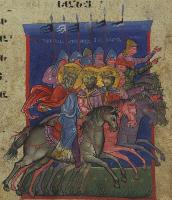The T'oros Roslin (or Sebastia) Gospels of Cilician Armenia, 1262
Folio 19r Return of the Magi
Folio 48r Christ Predicting the Sufferings of the Apostles
Folio 116v Betrayal of Christ

Folio 124r The Crucifixion
Folio 128v Soldiers Bribed by the Chief Priests
Folio 190r Judas Leads the Multitude
Folio 191r Apostle Fleeing
Folio 195r Christ is Scourged
Folio 305r Peter Denies Christ
From a Histoire d'Outremer c.1287
Turks and Armenians meeting at the foot of a mountain and signing a peace treaty
Armenian translation of Pseudo-Callisthenes’ History of Alexander the Great, c.1300-1325 by the scribe Nerses.
Armenian Cavalry, c.1300–1325AD
Armenian ruler addreses his army
Enthroned Armenian ruler and armoured guard

MIRROR SITES
druzhina345
Illustrations of Costume & Soldiers






 Reply With Quote
Reply With Quote

















